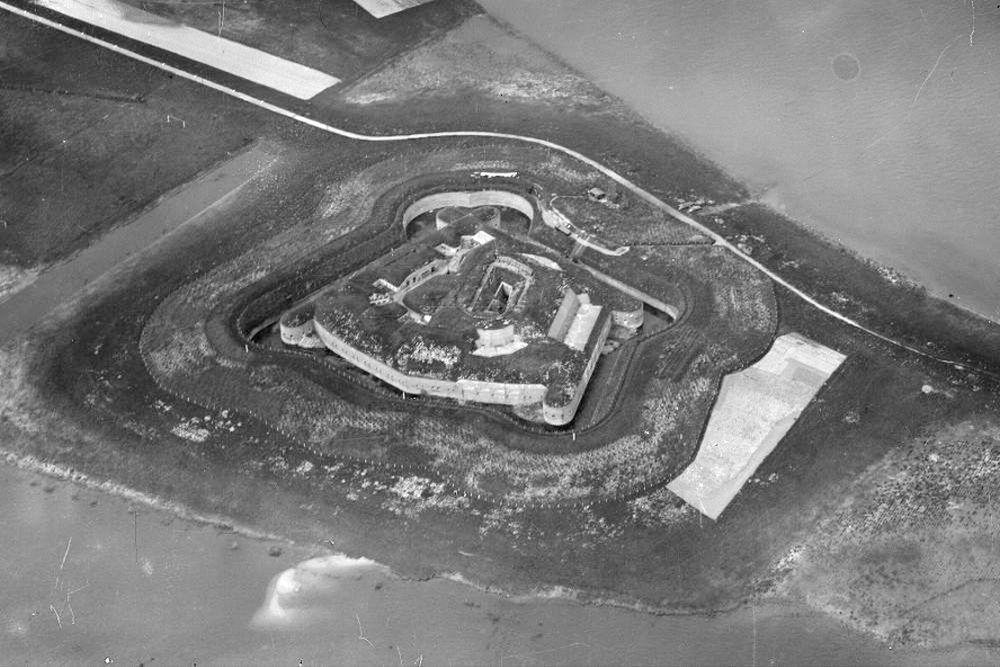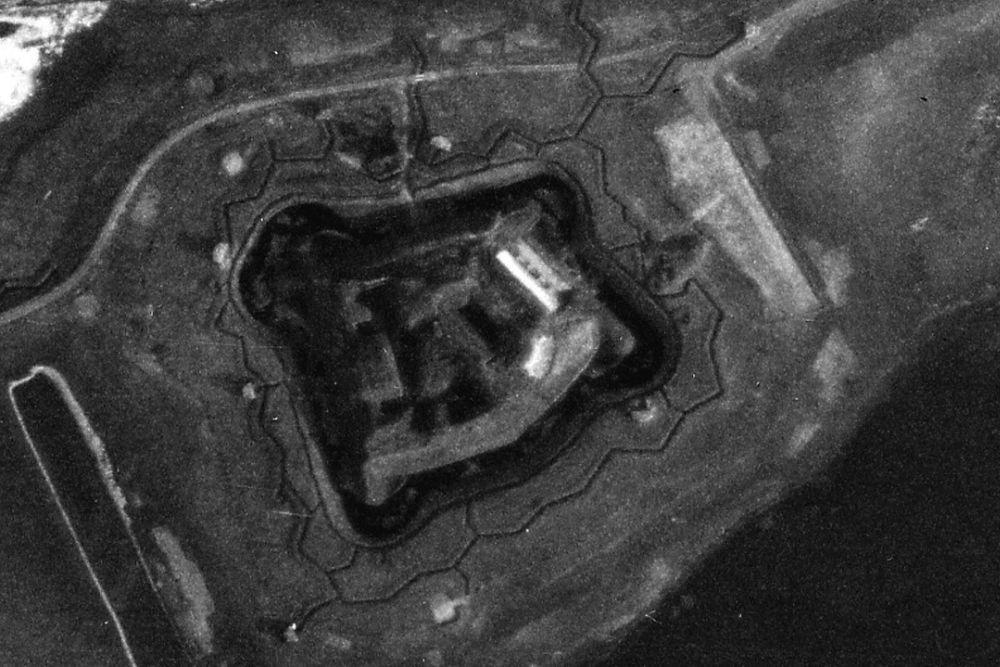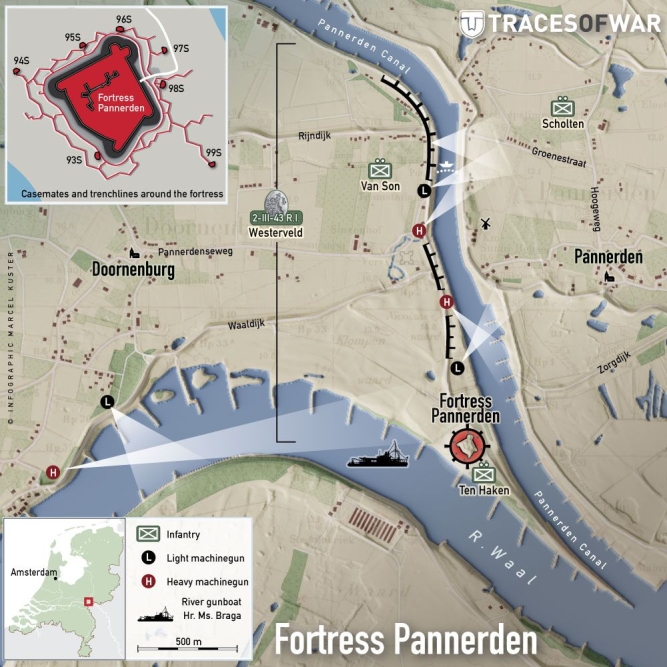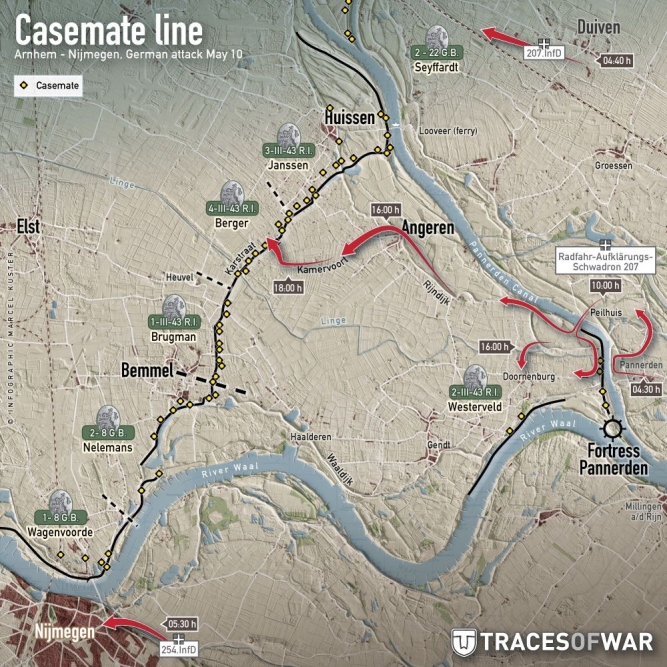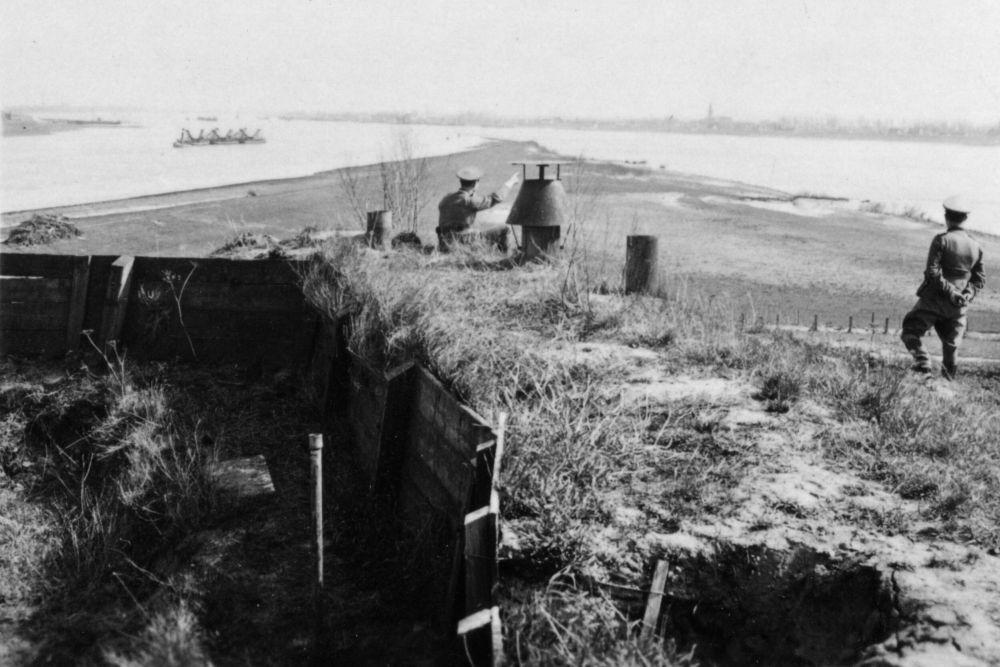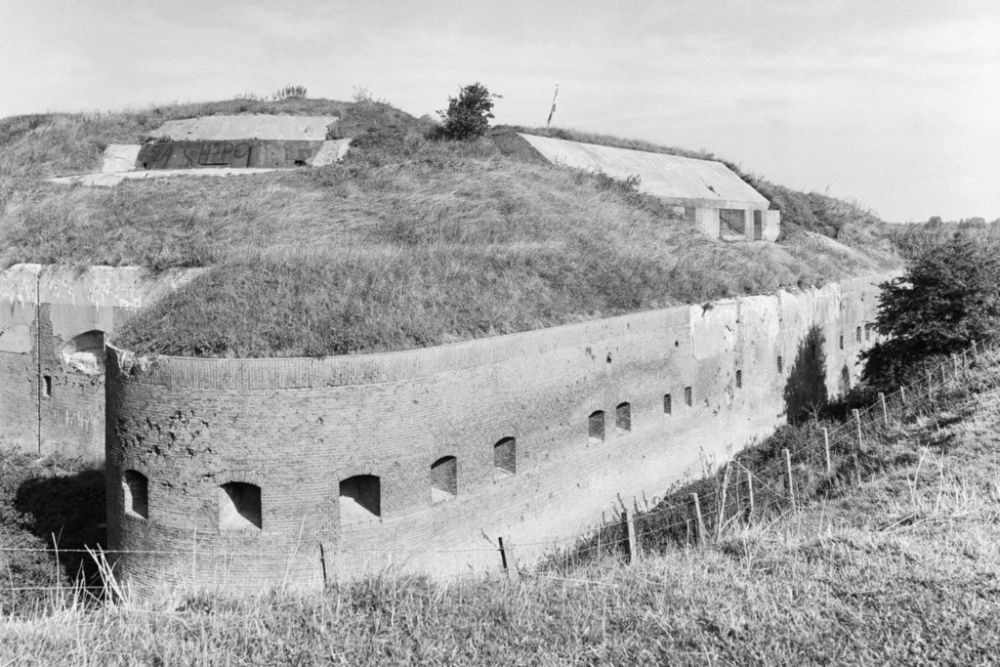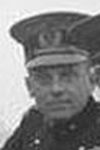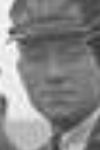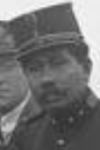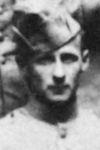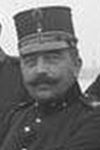Introduction
Near the village of Doornenburg, in an area previously known as West Pannerden, the former armored fortress Fort Pannerden is situated on a headland that splits the water originating from the Rhine river into the Waal river and the Pannerdensch Canal. Only two battles were waged for the fortress, during its entire history since its completion in 1871. The last time was in 2006, when squatters were expelled from the fort by riot police, assisted by the defense department. The first and only other time was on May 10th and 11th, 1940, when Germany invaded the Netherlands. In both cases, the siege of Fort Pannerden lasted about two days and there were no casualties. On May 10th, 1940, the German invader initially ignored the fortress, only to force it to surrender on May 11th at 19.30 hrs.
Fort Pannerden
Situated in West Pannerden, on the main dam near Pannerden (nowadays Doornenburg), Fort Pannerden was constructed between 1869 and 1871 as a so-called barrier fortress. Its main task was to protect the water supply to the Nieuwe Hollandse Waterlinie (New Dutch Waterline, a comprehensive 85km long defence system of fortresses and inundation infrastructure. Constructed between 1815-1940 to protect the economic centre of the Netherlands) further downstream. A significant part of the water, intended to flood the countryside covered by the Nieuwe Hollandse Waterlinie in the event of war, was supplied from the Rhine river via the Pannerdensch Canal, the Lower Rhine river and the Lek river. If an enemy could block-off the Pannerdensch Canal, most of the Nieuwe Hollandse Waterlinie would be rendered useless. As a secondary function, the fortress was assigned to protect the access to the Pannerdensch Canal and the Waal river. Already between 1880 and 1890 the Fort was considered outdated due to the introduction of newer weaponry and therefore converted into a so-called armored fortress. In the process, the armaments were also changed to match the new requirements.[1]
After the First World War (1914-1918), the importance of the Nieuwe Hollandse Waterlinie diminished and alternative defensive lines were designed. Because Fort Pannerden had lost any meaning for national defence purposes, it was de-classified as a fortification in 1926. It was no longer garrisoned; only a guard’s house was maintained at the access road from which the fort could be kept under surveillance. Gradually the fortress was cleared of armaments and other movable equipment that could be put to use elsewhere. Only four 150 mm guns in the main battery were retained. In the 1930s, the purpose of Fort Pannerden was re-considered as the threat of war emerged again. This mainly involved a function as an infantry post with the objective of delaying any enemy advance for as long as possible. Slowly but surely, Fort Pannerden was made operational and was given its original task after all in protecting the water supply; this time for the Grebbelinie (Grebbe Line: a forward defence line of the Nieuwe Hollandse Waterlinie and ran from the Grebbe hill, strategically overlooking the Lower Rhine river, northwards until the IJsselmeer lake) and as defence against a potential enemy wanting to invade our country via the Rhine. Due to lack of suitable ammunition, the 150 mm gun was no longer usable and two pieces of 75 mm L/40 coastal guns (made available by the Koninklijke Marine - Royal Netherlands Navy) were deployed instead. Furthermore, the fort was garrisoned with infantry and seven modern casemates, made of concrete, were built around the fort. They consisted of four S3a (a type of casemates with three loopholes) for light machine guns and three SzwFr (a casemate designed for heavy machine guns and also equipped with three loopholes), which were connected by a line of trenches.[2]
The Dutch defence
Fort Pannerden was incorporated in the "Strategic Security" of the Betuwe region (a line of casemates between the cities of Arnhem and Nijmegen) as an outpost. This line was manned by soldiers of the Groep Betuwe (Betuwe Group) of Brigade A (Kolonel (Colonel) Jan van Voorthuijsen). This strategic security was established in April 1939 and was manned by the 8e Grensbataljon (8th Border Battalion) under the command of Reserve Majoor (Reserve Major) J. Clerk, the IIIe Bataljon, 43e Infanterie Regiment (IIIrd Battalion 43rd Infantry Regiment) under the command of Majoor (Major) Cornelius Maria van Hal and the 11e Compagnie Pontonniers (11th Company Pontonniers). In addition, border guard detachments had been stationed in the small towns of Pannerden, Ghent and Beek, and other guard detachments had been posted at the bridges crossing the Waal river near Nijmegen, whereas the Groep Betuwe had been supplemented by the Groep Lent (Lent Group) of the police forces. The 2e Compagnie, IIIe Bataljon, 43e Infanterie Regiment (2nd Company, IIIrd Battalion, 43rd Infantry Regiment) was positioned around Fort Pannerden, commanded by Kapitein (Captain) Gerhardus Wilhelmus Westerveld. This company consisted of approximately 150 men, with sections of approximately 33 men each and a machine gun section.[3][4][5]
Until December 1, 1939, all these units were organized as a Groep (Group), first under the command of the commander of the 8e Grensbataljon and shortly later under the command of its own staff. This was again commanded by the Territoriaal Bevelhebber van Overijssel (Territorial Commander of the province of Overijssel). From December 2nd, 1939, they were placed under the commander of Brigade A. They had to occupy a line of defence that ran from a location opposite the mouth of the Maas-Waal Canal, to Fort Pannerden and then along the Pannerdens Canal to the opposite side of the access to the IJssel river. This line was later replaced by a straighter line of defence through the Betuwe region via the villages of Bemmel and Huissen to the Pannerdens Canal, with Fort Pannerden as an advanced infantry support base. The 43e Infanterie Regiment was set up as a mobilization unit for the 19e Infanterie Regiment (19th Infantry Regiment), a unit with a history at Fort Pannerden. Ever since Fort Pannerden became operational, the Artillery unit was primarily concerned with operating the artillery at Fort Pannerden. The defense of the fortress itself was the responsibility of the Infantry. Initially, a detachment of the 8e Infanterie Regiment (8th Infantry Regiment) was garrisoned at the fortress on a rotating basis. During the First World War, the defensive responsibilities were taken over by detachments of the 19e Infanterie Regiment, which emerged from the 8e Infanterie Regiment. This unit remained in use for this purpose until approximately 1921, after which it regularly dispatched detachments to the fortress for training excercises. From April 1939, the 1e Sectie, 3e Compagnie, IIIe Bataljon, 19e Infanterie Regiment (1st Section, 3rd Company, IIIrd Battalion, 19th Infantry Regiment) was stationed at Fort Pannerden as a border guard. The 2e Compagnie, IIIe Bataljon, 43e Infanterie Regiment was built up around this section from May 1939. Many members of the 1e Sectie remained with this new unit, including Kapitein Westerveld, who also belonged to the 19e Infanterie Regiment.[6][7]
Fort Pannerden and a number of defensive positions along the Pannerdens Canal (four positions) and the Waal river (two positions) were taken up by the 2e Compagnie, IIIe Bataljon, 43e Infanterie Regiment with a section of machine guns and two 75 mm naval guns of the Koninklijke Marine (Royal Netherlands Navy) positioned at the fortress itself. The seven casemates that had been built around the fortress, of which the concrete had not yet completely hardened on May 10th, contained positions for 5 light machine guns and 3 heavy machine guns. It is unclear whether the machine guns were actually installed in the casemates. The battle reports do not provide a definitive answer to this, although an ordnance survey map accompanying the reports does indicate the firing distances and directions from these casemates. One section was located on and around the fortress and another section in the defensive positions further away, along the Pannerdensch Canal and the Waal river. One detachment of this company was positioned on the opposite side of the Pannerdens Canal as a border guard (the Grenswachtdetachement Aerdt - Aerdt Border Guard Detachment), an observation post and, together with some torpedists, as a protection unit for the ferry at Pannerden. The Grenswachtdetachement Aerdt was commanded by Reserve 2e Luitenant (Reserve 2nd Lieutenant) E. Scholten. This detachment also served as an observation unit for Kapitein Westerveld.[8][9]
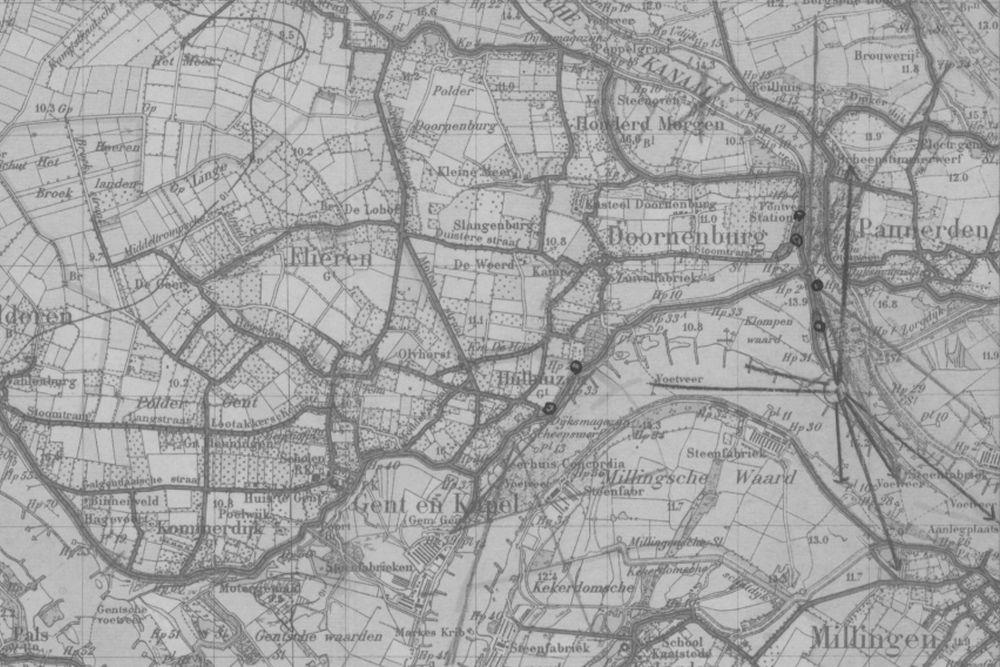
Ordnance survey map showing, among other things, the firing lines from the casemates around Fort Pannerden Source: NIMH
For the benefit of the two 75 mm L/40 naval guns, a detachment of the Koninklijke Marine was stationed at the fortress. Luitenant-t-Zee 1e Klasse (Lieutenant Commander) Hendrik Willem Adriaan Madsen, the commanding officer of the Bewakings- en Onderzoekingsdienst Bovenrivieren (Upper Rivers Surveillance and Research Service), advised Kapitein Westerveld on the deployment and training of naval personnel. He discovered that the navy people had no training at all in operating these specific guns. In order to overcome these shortcomings, he spent several days training them with the gun on board the river gunboat Hr. Ms. Tyr (1878) on the IJsselmeer. The continuation of the line along the Pannerdensch Canal up to the position of the Betuwe Group itself consisted of a number of fortifications along the canal itself, with two light and two heavy machine guns. On the other side of the fortress there was also a fortification position along the Waal river with a light and a heavy machine gun. The most important tasks for the occupation of Fort Pannerden were "to combat hostile activities on the river and to counter any attempts to block the Pannerdensch Canal in such a way that the water level in the Neder-Rijn and IJssel would drop significantly, thereby hampering inundations of the Grebbelinie and the Vesting Holland (Fortress Holland) behind it.[10][11]
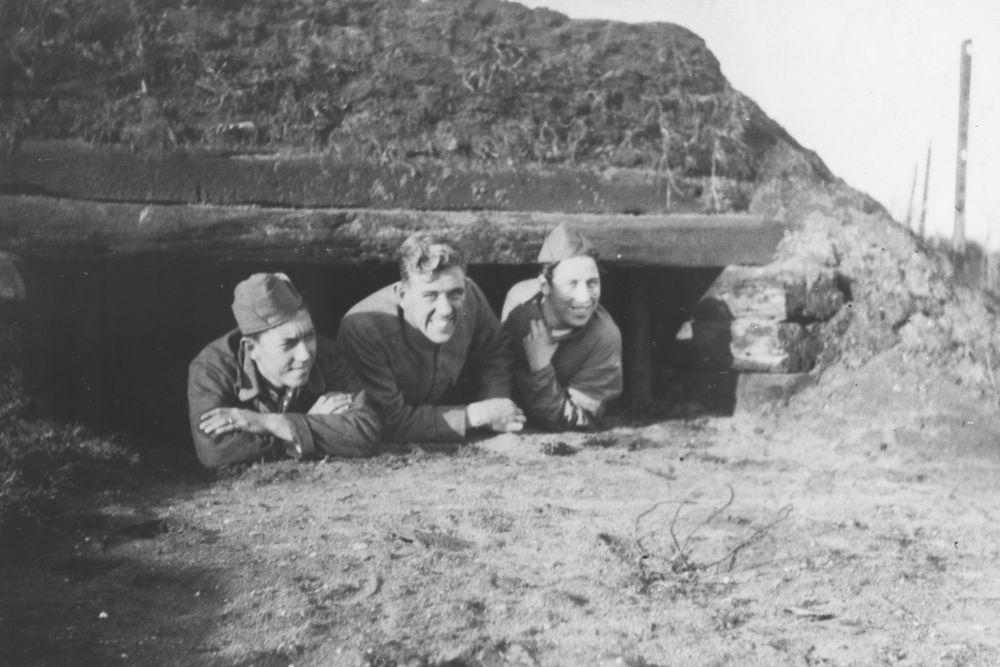
Casemates similar to the one shown in the photo were also built along the access road to Fort Pannerden and the dikes along the Waal river and the Pannerdensch Canal. In the battle reports these are referred to as casemtes although not all were made of concrete or stone. This is an example along the railway line near the village of Woudenberg Source: NIMH
In addition to the soldiers garrisoned in Fort Pannerden, the Dutch military presence around the fortress was strengthened by the river gunboat Hr. Ms. Braga (1878) , a Thor-class (1878) gunboat armed with a 120 mm L/40 N.2 gun, a 37 mm gun, and a 12.7 mm Vickers machine gun. The vessel was commanded by Luitenant-ter-Zee der 2e Klasse (Navy Lieutenant) Jan Hendrik Uiterwijk. The Braga was accompanied by the Defensie Motorsloep M 10 (Naval Motor Launch M 10), commanded by Bootsman (Boatswain) B.I. Wagenaar, and armed with a heavy machine gun. The Braga and the motor launch M 10 were part of a larger group of gunboats on the rivers nearby, called the Bewakings- en Onderzoekingsdienst Bovenrivieren.[12][13][14]
Finally, there was a defensive line set up beyond the defence postions directly surrounding Fort Pannerden. This defensive line consisted of trenches and field casemates (casemates made of packed earth and wood) spread along the Waal river (near the Banning pedestrian ferry and the Suikerdam machine gun position) as well as along the Pannerdensch Canal (along the access road to the fort and the dyke along the canal to approximately 200 meters north of another ferry). This defensive line was commanded by Reserve 1e Luitenant (Reserve 1st Lieutenant) Arie Johannes van Son.[15]
On the eve of the battle, all necessary preparations had been made. Near the village of Huissen on the Pannerdensch Canal, part of Fort Pannerden’s defensive line, landmine barrier No. 2 was installed and preparations had been made to blow up the ferry across the Pannerdensch Canal. Reserve 2e Luitenant E. Scholten, commander of the border section at Aerdt, had to report any border crossings to Captain Westerveld in Fort Pannerden by means of a so-called golden shining light. From the fortress, the crossing would then be reported by phone to the Commander of Brigade A. Kapitein Westerveld was assisted in the fortress by his deputy, Reserve 1e Luitenant Hendrikus Willem Hermanus ten Haken.[16]
The German forces
The German 18. Armee (18th Army), commanded by General der Artillerie (Lieutenant-general) Georg Karl Friedrich Wilhelm von Küchler, was designated to carry out the German invasion of the Netherlands. This army was assigned to the Heeresgruppe B (Army Group B) of Generaloberst (General) Moritz Albrecht Friedrich Franz Fedor von Bock. Within the 18. Armee were placed amongst others, the X. Armeekorps (10th Army Corps), commanded by General der Artillerie Christian Hansen, and the XXVI. Armeekorps (24th Army Corps), commanded by General der Artillerie Albert Wodrig. The X. Armeekorps was designated for the part of the Netherlands in which Fort Pannerden was located and consisted of the 207. Infanterie-Division (207st Infantry Division), commanded by Generalmajor (Brigadier) Carl von Tiedemann, the 227. Infanterie-Division (227th Infantry Division), commanded by Generalleutnant (Major-general) Friedrich-Karl von Wachter, and the Leibstandarte SS Adolf Hitler (motorisiert), commanded by SS-Obergruppenführer (Lieutenant-general) Josef Dietrich.
The 207. Infanterie-Division was earmarked for the attack on the area around the IJssel river and the Pannerdens Canal and would cross the border at the village of Elten. Specifically for the Betuwe region and therefore also Fort Pannerden, the Radfahr-Aufklärungs-Schwadron 207 (Aufklärungs-Abteilung 207 - Bicycle Reconaissance Squadron 207), commanded by Rittmeister (Cavalry Captain) Dietz, was assigned to reconnoiter and, if possible, conquer it. The Aufklärungs-Abteilung 207 (Reconnaisance Detachment 207) was established on August 26th, 1939, but reduced to squadron strength on February 10th, 1940 and as such designated as Radfahr-Schwadron 207 or also Radfahr-Aufklärungs-Schwadron 207. In the early morning of May 10th, this squadron had set-off from an assembly area near the German village of Hüthum, situated just across the border with the Netherlands.[17]
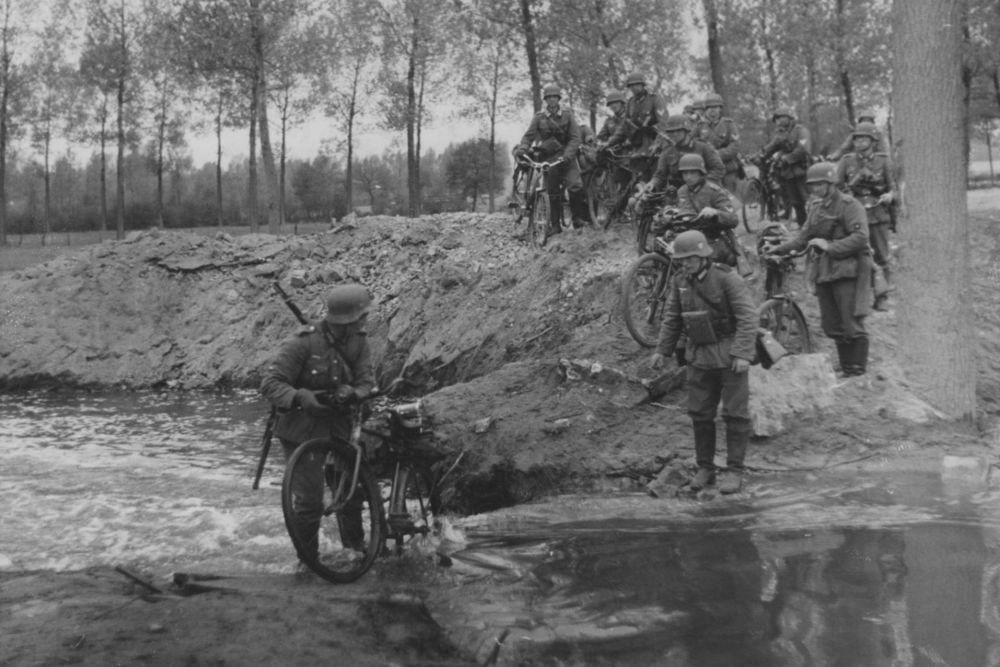
Example of a Radfahr-Aufklärungs-Schwadron; photo taken in France, 1940 Source: Public Domain (onbekend)
At the nearby German town of Dinslaken, Eisenbahn-Artillerie-Batterie 674 (Railroad Artillery Battery 674) was ready to be deployed if necessary. Their planned targets were Fort Westervoort and Fort Pannerden, once the IJssel river and the Pannerdens Canal had been crossed. The battery unit consisted of a single railway artillery unit (type “24 cm Theodor Bruno”), mounted with a 24cm Schnelladekanon L/40 C/94 (24 cm calibre rapid-firing gun). Facililtated by the local railway instructure, a firing position was set up 1 kilometer southeast of the German village Elten.[18][19]
The 'battle'
Around 03.55 hrs, on May 10th, the first German troops crossed the Dutch border, including north of the Pannerdensch Canal. These crossings were immediately reported according to the pre-agreed signals and other available means of communication. The previous night, 2e Luitenant E. Scholten, who commanded a section that was positioned north of the Pannerdensch Canal, had already observed signficant activities across the German border near the village Elten. Around 02.00 hrs during the night of May 9th to 10th, he noticed that buses were put in readiness on the German side of the border. As a precaution, he had already instructed any sectionmember that played no key-role in their surveillance tasks to fall back to the water gauge station near the ferry across the Pannerdensch Canal. Around 03.50 hrs, Scholten observed the first border crossings, reported this using the pre-agreed signal with a golden-coloured flash of light and returned by motorbike with the rest of his men to the water gauge station. The other sectionmembers had already crossed the canal and the boats for the rest of his platoon appeared to be on their way.[20][21][22]
A short time later, 1e Luitenant Arie Johannes van Son instructed a gendarme, a miner and a few civilians (Theodorus "Dorus" Scheers en Everhardus Johannes Wilhelmus "Eduard" Lucassen) managed to bring Scholten and his men to the other side in a rowing boat and a flatboat of the torpedomen. They were shot at by the Germans, and Lucassen was killed. Because of the ensuing battle, the body of this civilian could only be recovered after the hostilities had ceased. At 04.30 hrs on May 10th, German troops were first spotted north of Fort Pannerden, around the village of Pannerden itself. An attempt to blow up the ferry at Pannerden failed, as did an attempt to sink the ferry with a heavy machine gun. German armoured cars had appeared at the ferry stop on the Pannerden side of the canal and opened fire on the casemate across the canal, which returned fire, as well as on the other positions along the Pannerdensch canal and the access road to Fort Pannerden. After this exchange, the German troops ostensibly retreated northwards. Around 09.30 hrs, Luitenant Scholten left eastwards with his detachment to report to the staff of the Groep Betuwe in the small town of Elst.[23][24][25][26][27]
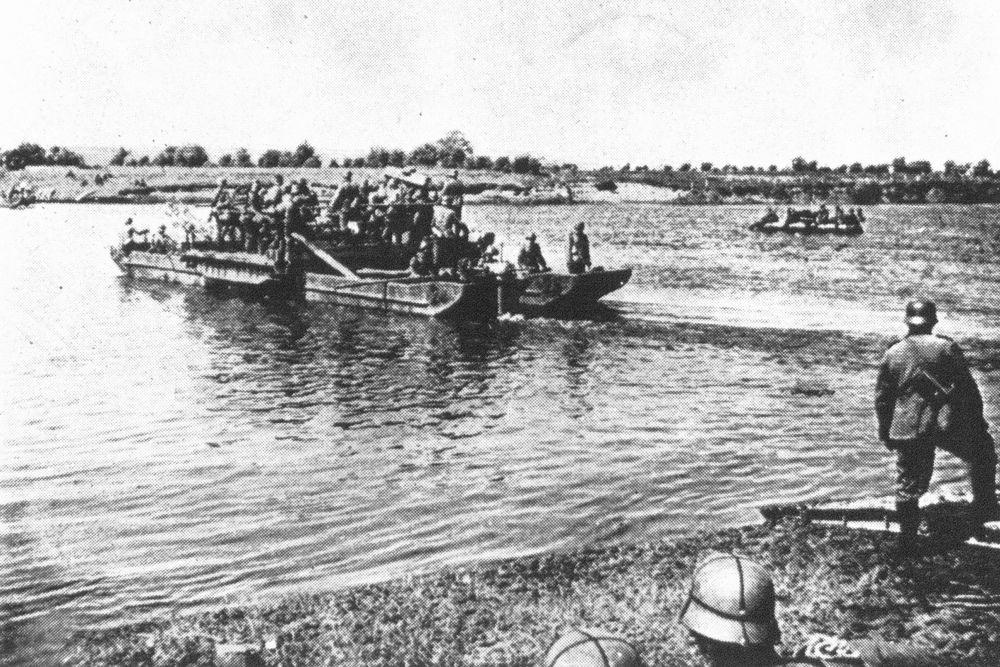
Similar as shown on this photo (likely made on the IJssel river near the village of Westervoort), the troops for the Betuwe region crossed the river by rubber dinghies and pontoons until a pontoon bridge was available Source: NIMH 2155_502055
Out of reach of the Dutch troops, groups of the German Radfahr-Aufklärungs-Schwadron 207 started to cross the Pannerdensch Canal around 10.00 hrs by rubber dinghies and later on a military vessel. Luitenant van Son, who commanded the troops along the Pannerdensch Canal, attempted to obstruct the river crossing with machinegun fire from his casemates, but this failed due to the large distance. Around 12.00 hrs, the Germans also managed to transfer some artillery across the canal. Around 15.00 hrs, Luitenant van Son ordered his troops along the Pannerdensch Canal to withdraw to the pub of the ferryman Banning near Doornenburg, close to where the pedestrian ferry serviced Waal river crossings between the villages Millingen and Doornenburg. He himself went to the fortress to report on the situation to its commander and receive further orders. At 13.25 hrs, a report mentioned that the German troops had crossed the Pannerdensch Canal with even more equipment and men and were advancing from the Doornenburg area towards Huissen. At that time, incoming reports claimed that two pontoon bridges had now been built across the Pannerdensch Canal. However, this reporting was incorrect as the German troops had been transferred to the Betuwe in boats only. It was only around 16.00 hrs that the first pontoon bridge in the area was laid across the IJssel river near Westervoort. The aforementioned Radfahr-Aufklärungs-Schwadron 207 was allowed to reconnoitre the area towards Fort Pannerden, but was instructed to ignore the fort itself and continue the reconnaissance towards the town of Elst further west.[28][29][30][31][32]
At Fort Pannerden itself, Kapitein Westerveld had already placed his troops in position at 03.00 hrs due to reports of unrest along the border. Around 03.55 hrs on May 10th, it was observed that large groups of aircraft were flying over from Germany to the west, which was immediately reported by Westerveld to his superior in Elst. Less than half an hour later, the border crossings by land were reported by the section commander north of the Pannerdensch Canal. Commander Westerveld then ordered 1e Luitenant van Son to destroy the ferry, which initially failed. Because German troops had started firing from the other side of the Pannerdensch Canal, several telephone lines were destroyed, including the connection between the fort and the group commander in Elst. Westerveld then sent several orderlies to Elst. Meanwhile, German armored cars had appeared on the dike on the other side at Pannerden and immediately began to bombard the fortifications along the dike at Doornenburg and the supply road to Fort Pannerden. The Dutch side returned fire with the machine guns available. The two naval guns on the fortress could not be used in this instance as they were positioned inside the fort with a firing opening towards the east only. The guns have been put to use at least once, when a German patrol boat steamed towards Millingen and then took shelter behind other vessels. According to a diary of Matroos 2e klasse (Ordinary Seaman) Joseph Valkenburg, a total of three shots were fired, with one shot being fired at the Millingen ferry on the Rhine. Matroos (Junior Seaman) Broer Eggen stated that only one shot had been fired, at a rowing boat which later turned out to be owned by a farmer. Regardless of how many shots were actually fired, not a single one hit a target.[33][34][35][36]
Around 15.45 hrs, Luitenant van Son left the fortress again to join his men that had assembled in the pub. On the way, he finds that the Germans had already taken hold of all his former positions up to the ferry to Pannerden. When he arrived at the café, it turned out that some of his men had left for Bemmel and Elst and the first of them had already been sighted in Bemmel around 15.30 hrs. Some of these men were assigned to the company reserve, while others were sent through to Elst. Around 16.30 hrs, he noted that German soldiers had reached the area around the church in Doornenburg. He then decided to leave for Elst himself, which was not possible due to the German presence. He put on civilian clothes and spent the night with residents of Doornenburg. Next morning, on May 11th at around 08.30 hrs, he ordered his remaining men to put on civilian clothes and go to Elst. He passed on the situation to an orderly who had been sent from the fort to Doornenburg in plain clothes and instructed him to report it back to his commander in the fort and point out that the enemy was setting up mortars and artillery in and around Doornenburg. Around 16.30 hrs, he himself left the area near Fort Pannerden and settled in Doornenburg. In the early morning of May 11th, Luitenant van Son again tried to reach the fort in civilian clothes, but after this failed he left in the direction of Bemmel. According to his observations, there were already around 120 German soldiers in Doornenburg.[37][38][39][40]
Immediately after it was learned on May 10th that German troops had crossed the border, the Braga river gunboat left Millingen and positioned itself on the Waal river near Fort Pannerden. At the request of Kapitein Westerveld, the commander of the Braga dispatched the accompanying motor launch Hr. Ms. M10, equipped with a machine gun, to the ferry in order to set it on fire. This succeeded, despite counterfire from German troops on the other side of the Pannerdensch Canal. After having heard that Millingen was occupied by the Germans, the Commander of Hr. Ms. Braga (1878), Luitenant-ter-Zee 2e Klasse (Navy Lieutenant) Uiterwijk, decided to run his ship ashore near Fort Pannerde. Before doing so, he destroyed the Pannerden ferry with the Braga’s 120 mm gun. After this, around 08.00 hrs on May 10th, he grounded the Braga at Fort Pannerden between two breakwaters, had the ship's 120 mm gun disabled and both the 37 mm gun and the 12.7 mm machine gun dismantled. Together with his crew and these two weapons, he then went to Fort Pannerden and placed himself at the disposal of Kapitein Westerveld.[41][42][43][44][45]
On May 11th, 1940, Kapitein Westerveld had ensured that all positions were duly occupied from 02.30 hrs as a German attack could be expected that day due to the increasing German presence in and around Doornenburg. Then, around 08.00 hrs, six German aircraft were sighted above the fort. These aircraft started attack dives on the fort, firing their guns at the various fortifications. Marinier 1e Klasse (Marine 1st class) Jan van Rijn returned fire with the Braga heavy machine gun, now placed on top of the fortress, as did several other gunners in and around the fort. At least one aircraft was hit, losing altitude as it flew away towards Germany. It is unknown if and where this aircraft landed. The crew of the Braga was deployed in the defense of Fort Pannerden, where the men also participated in various patrols. Matroos Piet Pes did not return from one of these patrols. His retreat may have been blocked by German soldiers. Several times, shots were fired from the Fort and the surrounding casemates at German patrols, who regularly showed up with and without vehicles on the dikes on the other side of the Pannerdensch Canal and the Waal river. Around 15.00 hrs, Kapitein Westerveld received a message by an orderly from his lieutenant in Doornenburg, stating that German troops had entered the village and were setting up artillery and mortars. Somewhat earlier, he had already received a message that his battalion commander and the rest of the battalion had already withdrawn from Elst towards the west. Kapitein Westerveld decided that it was time to attempt a breakout with the strongest possible force when darkness fell. To this end, a reconnaissance patrol was sent out to explore possible escape routes.[46][47][48][49][50]
Also on May 11th, the Gruppe Brückner, a unit of the Panzerjäger-Abteilung 207 (antitank troop detachment 207) of which one section had been removed, received orders to join the Radfahr-Aufklärungs-Schwadron 207 in the Betuwe for the capture of Fort Pannerden and Elst. This unit, commanded by Major Brückner, had left Anholt in Germany for Doesburg in the Netherlands on May 10th and initially had to hold the bridges over the IJssel river and the Lower Rhine after they would have been seized. However, these turned out to have been destroyed, after which the unit was initially held in reserve in the village of Angelo and then sent to Oosterbeek via Didam and Westervoort. This unit was then ordered to cross to the Betuwe and focus on clearing the area east of Elst and capturing Fort Pannerden. In addition to the Panzerjäger-Abteilung 207, this Gruppe Brückner consisted of the II. Bataillon, Infanterie-Regiment 374, an Aufklärungs-Schwadron of the Aufklärungs-Abteilung 207 and a battery of 105 mm guns of the Artillerie-Regiment 207. In total, this unit was made up of approximately 2,250 men and had some light and heavier artillery at their disposal. All these troops were transferred to the Betuwe at Oosterbeek by boats and possibly also pontoons, after which they moved east again, including towards Fort Pannerden.[51]
At 18.45 hrs, two German negotiators headed towards Fort Pannerden. One of them, Oberleutnant (1st Lieutenant) Dr. Speck immediately issued an ultimatum to 1e Luitenant ten Haken, who had been sent by Westerveld to conduct the negotiations. The fort had to surrender immediately, otherwise it would be bombarded by artillery and the six Junkers Ju 87 Stukas that were currently circling above the fort. The Germans suggested that the fort surrender to avoid unnecessary bloodshed. The lieutenant responded that he was not authorized to agree to this and requested a postponement for consultation with Captain Westerveld. This postponement was obtained and valid until 19.30 hrs. Captain Westerveld then convened a war council with Reserve 1e Luitenant ten Haken, Luitenant-ter-Zee der 2e Klasse J.H. Uiterwijk and Luitenant-ter-Zee der 3e Klasse Frederik Petrus Antonius Jamin. The situation seemed hopeless. It was deemed impossible that two infantry platoons, a small naval detachment and the crew of the Braga could engage effectively with two coastal guns facing eastwards only and a handful of machineguns that were available. It was concluded that they were cut off from any reinforcement by their own troops that had been withdrawn previously. On May 11th at 19.30 hrs, Fort Pannerden was surrendered to the Germans. The men were allowed to remain at the fortress until May 12th, after which they were taken into captivity to Germany, via Nijmegen.[52][53]
Epilogue
Afterwards, Kapitein Westerveld had to answer for what the armed forces perceived as quick and easy surrenders. Although he was initially convicted for this in 1942 by the Military Chamber of the District Court of Justice in The Hague, he was acquitted on April 7th, 1943 by the Court of Appeal in The Hague.[54][55]
It is unclear to what extent the Germans put the fort to actual use during the occupation period. Often, the fort was guarded by some Wehrmacht soldiers or German-minded civilians.
Anti-aircraft guns are said to have been positioned on or close to the fort during a certain period. To date this could not be confirmed. From a report written in 1943 by some youngsters, we learn that they tried to enter the fort on August 3, 1943, but that they found it abandoned and bricked up.[56]
In dispatches of the resistance of March 28, 1944, it was reported that on March 25th, 1944 the loopholes of the fort and the surrounding pillboxes had been cleared for use again and that two concrete bunkers to accommodate machine guns had been placed on top of the fort. These machine gun nests would each have one large and two smaller loopholes facing east. It was reported that the fort was guarded by a Dutch civilian stationed on a vessel close to the fort. This guard was replaced every week and the Millingen ferryman reported that work had been stopped that same week by order of a German officer.[57]
In the aftermatch of Operation Market Garden and the subsequent consolidation of the frontlines in the Betuwe region, elements of the 10. SS-Panzer-Division would either have been garrisoned at the fort or were partly situated there. This presence has not been verified yet.
The river gunboat Braga was salvaged in 1940 and taken to Germany (possibly nearby Emmerich). It is likely that the boat was subsequently scrapped.
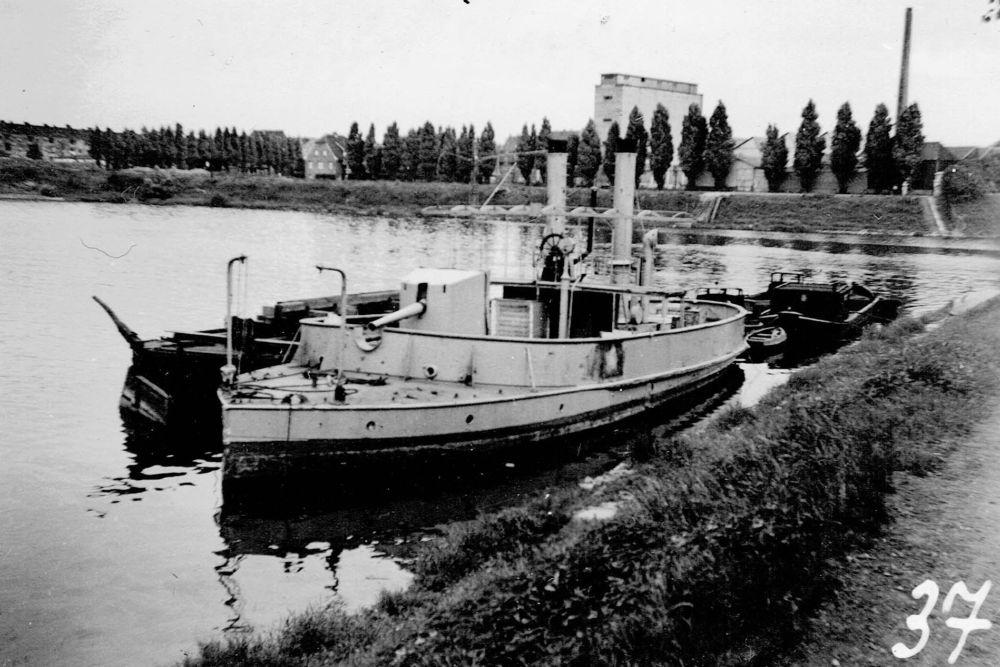
Probably the Braga, after the boat had been salvaged, lying in the harbour of Emmerich (although this is likely, it is not yet certain; further information is always welcome) Source: Public Domain (via John van der Maas?)
Notes
- Heijden, 2012, pag. 31-78
- Heijden, 2012, pag. 78-98
- Nierstrasz, 1947, pag. 102
- Nierstrasz, 1955, pag. 554
- Westerveld, 1940, pag. 1
- Nierstrasz, 1952, pag. 77
- Haafs, februari 2024
- Westerveld, 1940, pag. 1
- Son, juli 1940, pag.1
- Nierstrasz, 1952, pag. 78-80, 106
- Madsen, 1940
- Nierstrasz, 1952, pag. 79
- Ministerie van Oorlog, 1940
- Madsen, 1940
- Westerveld, 1940, pag. 1
- Nierstrasz, 1952, pag. 82-83
- Ruissen, 2012, pag. 20
- Ruissen, 2012, pag. 3
- BA-MA, RH 24-10/44, 1944, pagina 164-170
- Nierstrasz, 1952, pag. 84
- Westerveld, 1940, pag. 1
- Scholten, 1940-1951, pag. 1
- Nierstrasz, 1955, pag. 558
- Nierstrasz, 1952, pag. 90
- Westerveld, 1940, pag. 1
- Son, mei 1940, pag. 1
- Scholten, 1940-1951, pag. 1
- Nierstrasz, 1955, pag. 41
- Hal, 1940
- Nierstrasz, 1952, pag. 90
- Westerveld, 1940, pag. 2
- Son, juli 1940, pag.1
- Nierstrasz, 1952, pag. 91
- Westerveld, 1940, pag. 1-2
- Haafs, deel 1, december 2023, pag. 5
- Haafs, maart 2024, pag. 3
- Nierstrasz, 1952, pag. 90
- Brugman, 1940, pag. 1
- Westerveld, 1940, pag. 2
- Son, juli 1940, pag.1-2
- Uiterwijk, 1940
- Nierstrasz, 1952, pag. 92
- Westerveld, 1940, pag. 1-2
- Madsen, 1940, pag. 1-3
- Son, juli 1940, pag.1
- Brongers, 2008, pag. 10
- Nierstrasz, 1952, pag. 92
- Westerveld, 1940, pag. 3
- Uiterwijk, 1940
- Madsen, 1940, pag. 3
- Nierstrasz, 1955, pag. 565
- Nierstrasz, 1952, pag. 93
- Westerveld, 1940, pag. 4-5
- Nierstrasz, 1952, pag. 105
- Westerveld, 1940
- Valk, 1943, pag. 7-10
- Geheime Dienst Nederland, 10 mei 1944, pag. 115
Information
- Article by:
- Wilco Vermeer
- Translated by:
- Simon van der Meulen
- Published on:
- 14-11-2024
- Feedback?
- Send it!
Related themes
Related sights
Related persons
Sources
- HEIJDEN, P., VAN DER & RUISSEN, E., Fort Pannerden, Matrijs, 2012.
- HUTING, G., Fort Pannerden, Uitgave Stokerkade, 2017.
- BA-MA, RH 24-10/44, Kriegstagebuch X. Armeekorps, Ia, Anlage Kriegstagebuch Mappe B
- BRONGERS, E.H., Inventarisatie uit diverse bronnen van in de meidagen van 1940 tijdens of door de strijd in Nederland neergeschoten, vernielde of door vuur beschadigde Duitse vliegtuigen, weergegeven per provincie of gebied, Wijnandsrade, 2008
- BRUGMAN, G.W., Verslag 10 mei 1940, Commandant 1e Compagnie, IIIe Bataljon, 43e Regiment Infanterie, 5 juni 1940
- GEHEIME DIENST NEDERLAND, Van Rudi voor Karel, M-Bericht 300 (Aanvulling M-Bericht 98), 10 mei 1944
- HAAFS, W., BLOEMENDAAL, G.J., Fragment uit de belevenis Gert Bloemendaal uit Vorden ingedeeld bij 1e sectie 3-III-19 R.I., Vereniging Vrijwilligers Fort Pannerden, 23 februari 2024
- HAAFS, W., EGGEN, H. & M., Herinnering aan de mobilisatie tweede wereldoorlog door matroos Broer Eggen, Vereniging Vrienden van Fort Pannerden, 8 maart 2024
- HAAFS, W., FAMILIE VALKENBURG, Dagboek van matroos Joseph Valkenburg, Deel 1, Vereniging Vrijwilligers Fort Pannerden, 29 december 2023
- HAL, VAN, C.M., Verslag van de commandant van het IIIe bataljon van het 43e regiment infanterie, 1940
- MADSEN, H.W.A., Verslag van de commandant van de Bewakings en Onderzoekingsdienst Bovenrivieren en tevens van Hr.Ms. Tyr, 1940
- MINISTERIE VAN OORLOG, Dislocatie van de zeestrijdkrachten en marinevliegtuigen, 1940
- NIERSTRASZ, V.E., De strijd op Nederlands grondgebied tijdens de Wereldoorlog II / De Groene Serie, Deel 3. De operatiën van het Veldleger en het Oostfront -Vesting Holland, 1955
- NIERSTRASZ, V.E., De strijd op Nederlands grondgebied tijdens de Wereldoorlog II / De Groene Serie, Onderdeel C. en D. De verdediging van het Maas - Waalkanaal en De verdediging van de Over-Betuwe, 1952
- NIERSTRASZ, V.E., Beknopt overzicht van de krijgsverrichtingen der Koninklijke Landmacht, 1947
- RUISSEN, C.J., Geschut op de Wageningse Berg, De Duitse Artillerie bij Wageningen mei 1940, Amersfoort, 2012
- SCHOLTEN, E, Gevechtsverslag Grenswachtdetachement Aerdt, 1940-1951
- SON, VAN, A.J., Rapport Oorlogsverrichtingen Buitenkazematten 2-III-43, 27 mei 1940
- SON, VAN, A.J., Proces Verbaal Huishoudelijk onderzoek 2-III-43, 17 juni 1940
- SON, VAN, A.J., Verklaring aanvullende vragen Kolonel van Voorthuizen, 14 augustus 1940
- UITERWIJK, J.H., Gevechtsverslag Commandant van Hr.Ms. Braga luitenant-ter-zee 2e klasse J.H. Uiterwijk, 1940
- VALK, F., Het dagboek van Felix Valk, 1 augustus 1943 - 2 oktober 1943 17, 17 september 1944 - 29 februari 1945
- WESTERVELD, G.W., Verslag van de commandant van de 2e compagnie van het IIIe bataljon van het 43e regiment infanterie kapitein G.W. Westerveld, augustus 1940
